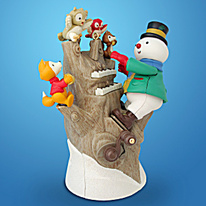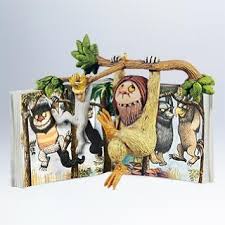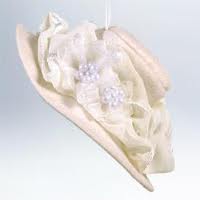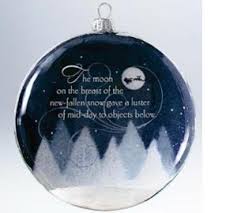Hallmark Ornaments 2011
-alphabetical by title-
Hickory Tree Harmony

Ornament Details artist: Ken Crow of note: features movement and sound This ornament features a jolly snowman playing an organ made out of a hollow tree, surrounded by some woodland friends. The symbol of a wooden tree is used fairly often in literature. Peter Pan and the Lost Boys live in a hollow tree, even Snow White seems to live a type of tree, since the dwarves' little cottage is so full of intricately carved wood. In fact, the first thing this ornament reminded me of is the scene in Disney's Snow White when the gang is all singing and dancing around an organ that looks a lot like this one. In fact, this oranment reminds me in several points of the story of Snow White.So what could this image be saying? There are many things, but the most important is St. Paul's admonishment to always speak in Love. He says "If I speak in the tongues of man or angels, but have not love, I am only a resounding gong, or a clashing cymbal." (1 Cor 13:1-3) If I speak without Love, I am only a noisemaker, another distraction to be tuned out. But the big question is how does one speak with Love? This ornament gives a good visual answer. First of all, Love is not a warm fuzzy, or even an emotion at all. In fact, if you do feel an accompanying happy emotion you can basically just consider yourself lucky. Love is seeking the true good, and requires sacrifice, effort, ongoing formation and ongoing conversion, much as learning to sing and play the organ, in fact. The biggest example, of course, is the greatest act of Love ever - Jesus' voluntary death on the tree of the cross. As Scripture plainly and openly says, Jesus certainly did not feel like going through his tortured last few hours, and none of it was pleasant and happy. But he did it because he sincerely and genuinely sought the True Good - to do the will of his Heavenly Father, which meant a very difficult subduing of himself, even to the point of sweating blood. It is this type of Love-speaking, or Love-music making that is lasting, formative and ultimately triumphant. Living the Wild Life

Ornament Details
artist: Sharon Visker Where the Wild Things Are Ah, Where the Wild Things Are - that delightful classic tale from childhood. This scene from Maurice Sendak's book shows Max at the height of his temper tantrum. He is fully engaged in swinging and swaying with the "wild things," having the time of his life. Where the Wild Things Are is essentially a childhood version of another famous story - the Parable of the Prodigal Son. In both stories, the young son disrespects the parent (in the Prodigal Son it is the Father, in Wild Things it is the mother) and leaves. They both go into "the wilderness" - the prodigal son goes physically to a place called "the great nothingness" in Hebrew. Max journeys in his imagination to the country of the wild things. Both sons experience a life without rules, boundaries or authority. It's wonderful! That is until they run out of their youthful arrogance. The prodigal son uses up all his money and ends up feeding slop to the pigs, while he himself starves. Once Max' anger subsides, he finds a gaping hole that only his mother's love can fill. This is one of those children's books that deserves more thought, reflection and application than a quick read through and dismissal. Read more HERE. She's got Hat-itude!
Ornament Details
materials: pearls, fabric, felt What is "Hat-itude?" We could say it is an attitude, for sure. A confidence big enough to yell "look at me! I've really got something!" But the question is, what does she have? What is the "hat-itude" this lovely white hat displays? What kind of woman is wearing it? Why is she wearing it? An article written by Fr. Robert Barron*, founder of the well-known "Catholicism" series, can shed light on the subject. In one of his reflections, Fr. Barron comments on Jesus' transfiguration as it is recounted in the gospel of Luke. The gospel states that "while Jesus was praying, his face changed in appearance and his clothes became dazzling white." Fr. Barron writes: The luminosity signals the invasion of God. When we have achieved a communion with the Lord, the light of God's presence is kindled deep within us, at the very core of our existence. It then begins to radiate out through the whole of our being. That's why it is so important that Luke mentions the clothing of Jesus becoming dazzling white. Clothes evoke one's contact with the outside world. When our clothes become radiant, we become light-bearers in the shadowlands. The God we discover in prayer should radiate out, through us, into the world, so that we become a source of illumination. Using clothing as an exterior symbol of the interior state is a common tool in all kinds of literature. This hat perfectly expresses the wearer's formation through prayer, especially of her mental formation. The joy and freedom she feels within is radiating outward. The hat shows her decision that she will "look good for the Lord." It is very big. It draws attention. It is attracting. Imagine a big smile under this hat, it cannot be worn without one. Everyone who saw it would stop and be drawn into that big smile, that engaging hat. This is about being clothed in righteousness. In recognizing your own worth before the Lord, without claiming it as your own, but recognizing it as gift - a show of humility. In thinking God-like thoughts that radiate from mind, to heart, to mouth. Wouldn't it be nice if everyone who loved Jesus wore their heart on their heads, just like this big hat? *Fr. Robert Barron is well-known for his excellent "Catholicism" DVD series. He also pens daily meditations during the Liturgical seasons. He is particularly passionate about spreading the New Evangelization. Visit his website at: http://www.wordonfire.org The Night Before Christmas
Ornament Details
artist: Sue Tague and Terri Steiger materials: glass with glitter "snow" inside the sphere In Christian symbolism, the moon is almost always connected to Mary. Just as the moon reflects the light of the sun, so does Mary reflect the light of Christ. She perfectly reflects it, yet never claims the light comes from her. Linking Mary to the moon is a very old tradition that appeared in the first years of the early church. Fast forward several hundred years, to 1822, when Clement Clarke Moore penned the famous poem known as "Twas the Night Before Christmas." A line from the poem is etched across the ornament's starry night: "The moon on the breast of the new fallen snow gave a luster of mid-day to objects below." Substitute in the language of faith and it could read "Mary's presence and prayers gives the light of Christ to those on earth." But what about Santa and the reindeer riding right across the face of the moon? How do we combine these two seemingly very distant traditions? Quite easily, in fact. Although Santa had his origins in the person of St. Nicholas, a real man who was bishop of Lycia in the 4th century, the red and white costumed, jolly flying man has very little direct connection. The person described in Moore's poem is not St. Nicholas, wonder-worker though he may have been. St. Nicholas has his own feast day on the Liturgical Calendar, and it's not Dec. 24. (It's Dec. 6, in case you were wondering.) Rather, this Santa with the tummy that shakes "like a bowl full of jelly" is an archetype of God the Father. You can read more about that soon on my Santa page (which is under construction.) So, this ornament perfectly expresses how from the beginning, God the Father intended to create a perfect, humble, unknown woman who would bring forth his holy son, never ceasing to bow to him and reflect his splendor throughout the ages. Just as the first creation was a common work of the Holy Trinity, so is the re-creation of the universe. (CCC 292*) The Holy Spirit is also represented, through the giant silver swirl emanating from the Father and moon, reaching out across the entire world. And in typical Holy Spirit style, it is almost an invisible element, there, but not what you remember about the ornament. And where is Christ? He's already on earth, represented by the snow that is not cold, soaking slowly into the hearts and minds of all who will receive him. *Catechism of the Catholic Church |
|

